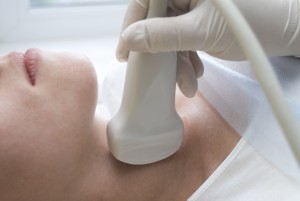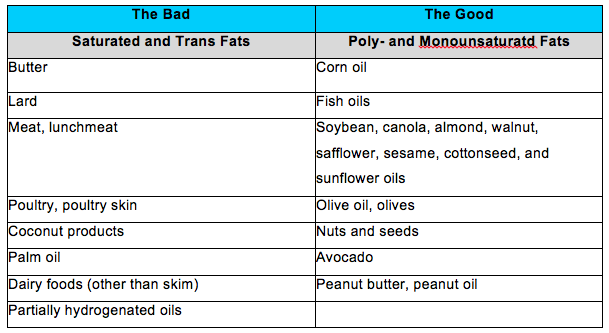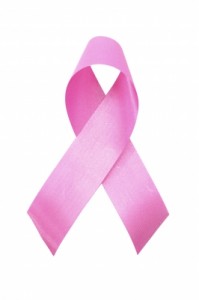Learn How a Thyroid Screening Can Save Your Life
 January is Thyroid Awareness Month, and for good reason. An estimated 20 million Americans suffer from some form of thyroid disease, and up to 60 percent are unaware of their condition. Women in particular are at risk for thyroid disease, and are five to eight times more likely than men to have thyroid problems. By understanding the symptoms and warning signs of thyroid diseases, including thyroid cancer, and committing to regular check-ups, you can reduce your risk of developing a serious health condition.
January is Thyroid Awareness Month, and for good reason. An estimated 20 million Americans suffer from some form of thyroid disease, and up to 60 percent are unaware of their condition. Women in particular are at risk for thyroid disease, and are five to eight times more likely than men to have thyroid problems. By understanding the symptoms and warning signs of thyroid diseases, including thyroid cancer, and committing to regular check-ups, you can reduce your risk of developing a serious health condition.
The Thyroid’s Role in Regulating Your Metabolism.
Your thyroid is a butterfly-shaped endocrine gland located in your neck just above your collarbone. It produces hormones that help your body regulate your metabolism. When not functioning properly, it can cause your system to accelerate, a condition known as hyperthyroidism, or decelerate, a condition known as hypothyroidism. Symptoms of hyperthyroidism include rapid weight loss, high blood pressure, anxiety and insomnia. Symptoms of hypothyroidism include a weak or slow heartbeat, muscular weakness, constant fatigue, weight gain, depression, slow reflexes, sensitivity to cold, puffy skin, slowed mental processes and poor memory, and constipation.
Thyroid Diseases.
Other thyroid diseases may include:
- Thyroid nodules – lumps in the thyroid gland
- Thyroiditis – swelling of the thyroid
- Goiter – an enlargement of the thyroid gland often causing difficulty swallowing or breathing
Thyroid Cancer.
Thyroid cancer is the fifth most common form of cancer in women. Women are at a greater risk for developing thyroid cancer if they:
- Are between ages 25 and 65
- Are Asian
- Have a family member who has had thyroid disease
- Have had radiation treatments to their head or neck
You should see a doctor if you have a lump or swelling in your neck. To test for Thyroid cancer your doctor will likely perform a physical exam, blood tests, imaging tests, and a biopsy. Treatment options depend on the type of thyroid cancer you have and how it has developed. Treatment may include surgery, radioactive iodine, hormone treatment, radiation therapy, chemotherapy, or targeted therapy.
The Benefits of Self-exams.
Examining your neck on a regular basis may help you identify lumps or enlargements that are indicative of thyroid disease. To perform a self-exam:
- Use a mirror to study the lower middle area of your neck, above the collarbones, and below the larynx.
- Tip your head back, take a drink of water, and swallow.
- Look at your neck and check for any bulges near your collarbone.
If you do see a protrusion in the area of your thyroid, schedule an appointment with your doctor.
The Benefits of Screenings.
Thyroid-stimulating hormone (TSH) testing is a simple blood test that measures whether your thyroid gland is functioning normally. Ask your doctor about a TSH test if you:
- Are over 60 years of age
- Have recently been pregnant or have delivered a baby within the last six months
- Have a family history of thyroid disease
- Have previously been treated for a thyroid problem
- Have had neck surgery or radiation
- Have pernicious anemia (a vitamin B12 deficiency)
- Have type 1 diabetes
- Have primary adrenal insufficiency
According to The American Thyroid Association, thyroid function should be measured in all adults beginning at age 35 and every five years thereafter. Women taking synthetic thyroid hormone replacements should have a TSH blood test at least once per year. Women with a history of thyroid problems who are pregnant or trying to become pregnant should discuss more frequent testing with their doctors.
More
Five Simple Lifestyle Changes for 2016
 New Year’s resolutions: we all make them; we all break them. Too often we set ourselves up to struggle with our New Year’s commitments by setting goals that are too aggressive. Losing 20 pounds by February first, running a sub-three hour marathon with no training, or turning-in your burger habit for a lacto-ovo-vegetarian diet may not be a safe, healthy, or obtainable goal for most people. Fortunately, there are simple ways to make changes to your lifestyle in 2016 that won’t make you feel overwhelmed by your commitment.
New Year’s resolutions: we all make them; we all break them. Too often we set ourselves up to struggle with our New Year’s commitments by setting goals that are too aggressive. Losing 20 pounds by February first, running a sub-three hour marathon with no training, or turning-in your burger habit for a lacto-ovo-vegetarian diet may not be a safe, healthy, or obtainable goal for most people. Fortunately, there are simple ways to make changes to your lifestyle in 2016 that won’t make you feel overwhelmed by your commitment.
Consider these five simple lifestyle changes that can help you to become a happier, healthier, you.
- Use Natural Skin Care Products. Your skin is your largest organ, which is why what you put on your body is just as important as what you put in it. Switching out chemically created skin products for natural, organic options is healthier for both you and the environment. Natural and organic products are designed to work with your body’s natural systems, which is why many women find natural products are gentler on their skin, causing less irritation. Check retailers in your local community as well. Choosing locally sourced products not only reduces environmental waste associated with shipping and distribution, it allows you to support your locally economy, which means everyone wins.
- Park Further Away. Walking is one of the simplest ways to get active. Every extra step you take during the day will help you to burn calories. In addition, a recent study found that women who increased their step count to nearly 10,000 per day reduced their blood pressure after 24 weeks. Another study of overweight women found that walking 10,000 steps a day improved their glucose levels.
- Swap Soda for Seltzer. According to researchers at Harvard University, each additional soda consumed increases an individual’s risk of obesity 1.6 times. Removing soda from your diet can help you control your weight and limit your daily sugar consumption. If you are drinking soda on a regular basis, replace it with seltzer water. Like soda, seltzer has a cool, bubbly effervescence, but without all of the sugar and chemical sweeteners. Add flavor with slices of fresh lemon or lime.
- Give Yourself an Extra 15 Minutes. Nothing can start your day off on a bad note than running late first thing in the morning. If you’re barely making it to work on time every day, adding stress to your mornings, try setting your alarm for only fifteen minutes earlier than your current wake-up time. Attempting to shift your sleep schedule too dramatically can be a difficult transition. An extra fifteen minutes may be all you need to wake up still feeling rested without the stress of having to rush.
- Save Your Spare Change. Small amounts of loose change can add up to big savings over time. At the end of every day, empty your wallet by placing your spare coins and single dollar bills in a jar or box. You likely will never miss these small amounts, but by the end of the year, you’ll have saved enough money to treat yourself to a massage, a new purse, or a new pair of running sneakers. As an alternative, you could deposit your funds into your emergency savings fund, or use the money to accomplish further good by donating it to charity.
Chouchani, Sayegh and Bagnarello MD is now accepting new patients!
Women over the age of 18 or who are sexually active are encouraged to see a GYN once each year for their annual exam. Being proactive is an essential part of maintaining a healthy lifestyle. Follow our blog for more articles on women’s health.
More
 Miscarriages are saddening medical occurrences that happen more often than is realized, yet the couples who suffer them rarely speak of their losses. Whether their silence is born out of a fear that the sympathies of others may make the loss more emotionally distressing, or out of a greater fear that a pregnancy may never be possible, miscarriages are often an emotional burden that too many couples bear alone. Such isolation is unnecessary, however, as approximately 10 to 20 percent of known pregnancies end in miscarriage, and as many as 50 percent of pregnancies are miscarried so early that the pregnancy is not even known. Though the early termination of any pregnancy can be heart breaking, couples looking to conceive should take comfort in knowing that they are not to blame or at fault for the loss of their fetus. Understanding the truths and overcoming the misperceptions of miscarriages can give comfort to those recovering from such a loss.
Miscarriages are saddening medical occurrences that happen more often than is realized, yet the couples who suffer them rarely speak of their losses. Whether their silence is born out of a fear that the sympathies of others may make the loss more emotionally distressing, or out of a greater fear that a pregnancy may never be possible, miscarriages are often an emotional burden that too many couples bear alone. Such isolation is unnecessary, however, as approximately 10 to 20 percent of known pregnancies end in miscarriage, and as many as 50 percent of pregnancies are miscarried so early that the pregnancy is not even known. Though the early termination of any pregnancy can be heart breaking, couples looking to conceive should take comfort in knowing that they are not to blame or at fault for the loss of their fetus. Understanding the truths and overcoming the misperceptions of miscarriages can give comfort to those recovering from such a loss.
Timing
The majority of miscarriages occur during the first 13 weeks after conception. Since many women wait to share news of their pregnancy with family and friends until after the first trimester, many of the miscarriages that occur during the first thirteen weeks are often unknown by anyone other than the mother and father.
Truth: A great number of miscarriages occur so early that even the couple is unaware that an embryo had formed.
Causes
Though it is commonly believed that lifting heavy objects, participating in dangerous activities, and long-term stress can cause miscarriages, none of these factors have been proven to be valid risk factors. It is believed that the majority of miscarriages are caused by genetic abnormalities within the embryo that would prevent a baby from fully developing healthily and surviving after birth. About 60 percent of the time, miscarriages occur when the embryo or fetus has an abnormal number of chromosomes. In addition, some illnesses may place a woman at a greater risk for miscarriage, including some viral infections, thyroid disease, and diabetes.
Truth: Fatal genetic errors are not usually caused by the mother’s genetics.
Risk Factors
Some of the risk factors that may lead to a miscarriage include:
- An older maternal age
- Extremely low or high maternal weight
- Moderate to high alcohol consumption during pregnancy
- Smoking or illicit drug use during pregnancy
- Use of nonsteroidal anti-inflammatory drugs (NSAID) around the time of conception
- Uterine trauma
- Previous miscarriage(s)
About 5 percent of women have recurrent miscarriages, a condition defined by three or more losses. In most of these cases, however, the recurrent miscarriages are caused by underlying health issues such as a structural problem with the uterus, thyroid problems, hormonal imbalances, or clotting disorders.
Truth: Most women who miscarry go on to have a successful pregnancy and give birth to a healthy baby.
Prevention
In order to be best positioned to deliver a baby to full term, women should maintain a healthy weight through proper nutrition and exercise, should not consume drugs or alcohol, and should be screened and treated if necessary for any sexually transmitted diseases (STD). In addition, pregnant women should take a folic acid supplement, avoid possible radiation exposure, and avoid contact sports.
Truth: In most cases, fully preventing a miscarriage is outside of a woman’s control.
The loss of any child at any time is devastating, however women must understand that as long as they lead a healthy lifestyle and avoid drugs and alcohol and other risky behaviors, they are giving their fetus the best possible chance for a healthy birth. For the many women who experience a miscarriage caused by genetic factors outside of their control, they should not take on the burden of guilt, or the feeling that the loss was their fault. Rather, they should emotionally and physically prepare themselves to try again to carry a baby full term, since for the great majority of women who miscarry, a healthy and happy baby is still on the horizon.
Whether you are pregnant or planning on becoming pregnant, it’s important to see your OB-Gyn. Our office is currently accepting new patients. Call for an appointment today.
More
 Sex should be a pleasing, and comfortable experience, so when our bodies inhibit our ability to truly enjoy intimate moments, it can be frustrating and discouraging–which may only further inhibit our ability to relax and enjoy the experience. Vaginal dryness is a condition that affects a significant number of women, but older women are particular susceptible. Vaginal dryness impacts more than half of post-menopausal women between the ages of 51 and 60. During menopause, women produce lower levels of the hormone estrogen. As a result, vaginal walls lose their elasticity, become tight and fragile, and are less able to accommodate the flexibility needed for comfort during sexual intercourse. In the most serious of cases, the vaginal walls can even tear or bleed during sex. If you are among the millions of women suffering from vaginal dryness, read the tips below to learn how to ease your symptoms and take back your comfort and confidence in the bedroom.
Sex should be a pleasing, and comfortable experience, so when our bodies inhibit our ability to truly enjoy intimate moments, it can be frustrating and discouraging–which may only further inhibit our ability to relax and enjoy the experience. Vaginal dryness is a condition that affects a significant number of women, but older women are particular susceptible. Vaginal dryness impacts more than half of post-menopausal women between the ages of 51 and 60. During menopause, women produce lower levels of the hormone estrogen. As a result, vaginal walls lose their elasticity, become tight and fragile, and are less able to accommodate the flexibility needed for comfort during sexual intercourse. In the most serious of cases, the vaginal walls can even tear or bleed during sex. If you are among the millions of women suffering from vaginal dryness, read the tips below to learn how to ease your symptoms and take back your comfort and confidence in the bedroom.
- Foreplay. It may sound like a simple solution, but too often the many constraints on our time cause us to rush sexual intercourse. Without proper foreplay, we don’t allow our bodies the time necessary to properly self-lubricate and prepare for penetration. By increasing the length of foreplay, a woman can naturally improve her moisture levels and reduce dryness.
- Vaginal lubricants. These over-the-counter products are intended to be used during sexual intercourse to help ease repeated penetration by temporarily providing a more slippery surface. Avoid products that boast unnecessary features like flavors and scents, and choose a product that will meet your needs by improving your comfort.
- Vaginal moisturizers. For many women suffering from vaginal dryness, a simple over-the-counter vaginal moisturizer applied regularly can greatly improve wetness and comfort during sex. Similar to body lotion, vaginal moisturizers can be used as a maintenance product to reduce dryness and improve daily moisture levels.
- Vaginal estrogen treatment. The most effective treatment for moderate to severe cases of vaginal dryness is a vaginal estrogen treatment. By increasing estrogen levels in the body, vaginal walls are restored to their pre-menopausal thickness, and will produce greater levels of vaginal mucus and secretions. There are three treatment options for vaginal estrogen. Treatment can be obtained in the form of an oral tablet, vaginal cream, or vaginal ring, which lasts for three months before needing to be replaced. Women at high risk for breast cancer should avoid estrogen supplements, especially if taking aromatase inhibitors to lower their breast cancer risk.
- Selective estrogen receptor modulators (SERM). SERMs are taken orally to help restore vaginal moisture and mucous. Ask your GYN if a SERM treatment may be right for you, but know that such oral treatments may increase your risk of blood clots and hot flashes.
- Vaginal dilators. In the most serious cases of vaginal dryness, the treatments above many not be enough. Prescription vaginal dilators are soft plastic rods in gradual sizes, ranging from three millimeters to ten millimeters in diameter. Their repeated insertions help allow for a gradual increase in overall vaginal dilation capabilities.
Most importantly, you don’t have to shy away from sex. When sex becomes uncomfortable, a natural reaction can be to avoid intercourse – and the pain associated. However, continued sexual activity, including masturbation, allows the vagina to maintain a greater level of elasticity over time. By continuing to be sexually active (safely of course!) you can slow and lessen the signs of vaginal drying, even during menopause.
The doctors at Chouchani, Sayegh and Bagnarello can help you with any question about your sexual health. Contact us today to make an appointment. We are currently accepting new patients.
More
We crunch our abs, curl our biceps, and do countless squats to obtain a perfectly rounded butt, so why do we neglect our vaginal muscles? As women, our vaginas are incredibly important and versatile. The vagina acts as the birth canal, an outflow track for menstrual blood, and an in-flow track for sperm. The vaginal muscles can weaken over time, however, due to age, childbirth, and even smoking, resulting in issues such as incontinence. By making an effort to keep the vagina strong over time, women can experience more comfort and confidence as they age.
Signs of Weakened Vaginal Muscles
The signs of weakening vaginal muscles may include:
- Leaking urine when coughing or sneezing, or difficulty emptying the bladder
- Passing gas unintentionally
- Posterior prolapse, a soft bulge of tissue in the vagina that may or may not protrude through the vaginal opening
- A constant sensation of pressure in the pelvic region
How to Strengthen Vaginal Muscles
The secret to stronger vaginal muscles lies in a simple exercise known as the Kegel.
Kegel exercises are clench-and-release movements that can strengthen the pelvic floor — a series of muscles and tissues that forms a sling at the bottom of the pelvis. The pelvic muscles are essential, as they hold our organs in place. Kegels are not difficult, but in order for them to be the most effective, they must be done using the proper technique. As an added bonus, regular Kegel exercises can help women to be more in touch with their bodies, helping them to isolate sensations during sex and enhance their sexual satisfaction.
The best way to learn how to isolate the pelvic muscles is to Kegel during urination. When you start to urinate, clench your muscle to stop the flow of urine, and hold for 10 seconds. This technique will help you to identify how it feels to properly engage the pelvic floor muscles. Once you can easily identify and contract your pelvic muscles, try to incorporate Kegel exercises into your daily routine, ideally doing 50 Kegel contractions that are held for 10 seconds each, every day. Since no equipment is needed, you can Kegel anywhere, at any time. Try to Kegel during stoplights, during TV commercial breaks, or while reading.
With routine Kegeling, most women see improvement in the strength of their pelvic floor muscles within six weeks. If you Kegel regularly but do not see the desired results, talk to your GYN. You may benefit from more intense, dedicated work with a pelvic physical therapist — a specialist who is trained to help women improve the strength of their pelvic floor muscles. If you still aren’t feeling the results you want, your GYN may want to test you for pelvic floor dysfunction, a disorder that occurs when pelvic floor muscles are weak or tight, or when there is an impairment of the sacroiliac joint, lower back, coccyx, or hip joints. The majority of women though, will feel improvement through the simple addition of Kegel exercises into a daily routine, and as a bonus, will finally feel productive during television commercial breaks.
More
 How to Enjoy the Holidays without Adding to Your Waistline
How to Enjoy the Holidays without Adding to Your Waistline
The holidays are a time for family, friends, and quality time spent together. They are also a time for mashed potatoes, stuffing, and hot apple pie. If you are one of the millions of Americans who finds themselves gaining even a few pounds during the holiday season, know that this year, you can maintain, and not gain weight by simply making small sacrifices, smart choices, and staying active. Before you pledge an oath to skip all of your favorite holiday fare, review the seven tips below. You can still enjoy all of your most-loved foods this holiday season, without compromising on your health.
- Don’t starve yourself before a holiday meal. While you may think that skipping lunch will help balance out an extra-large dinner, understand that arriving to a holiday meal hungry may encourage you to eat even more than you would have if you had eaten a sensible lunch. If you do arrive hungry to an event, drink a glass of water before you start to nosh on appetizers to try to curb your initial hunger pangs.
- Weigh yourself twice a week. Bi-weekly check-ins with the bathroom scale will help you make sure that you are maintaining, and not gaining during the holiday season. Be sure to weigh yourself at the same time of the day, preferably first thing in the morning before you eat anything, to make sure you get the most accurate readings.
- Pace yourself through happy hour. It may be tempting to overeat when you are surrounded by trays of delicious appetizers, but try to keep in mind that every holiday event is a marathon, not a sprint. Sample just a few of the appetizers that are most appealing to you, and then save the rest of your appetite for the main meal.
- Don’t give-up your exercise routine. The holidays are often packed with events, parties, shopping, and more social obligations than any other time of the year. Don’t skip your exercise routine during the holidays to accommodate your busy schedule. Make sure to exercise for at least 30 minutes a day, three to five days a week.
- Plate your food responsibly. Whether you are at a buffet or eating family style, curb the temptation to pile your plate with teetering towers of food doused in a layer of gravy. Take the smallest plate available and select reasonable portion sizes of just those items you want the most.
- Don’t skip desserts – but limit your portion sizes. You don’t have to skip your Mom’s famous, once-a-year apple pie, but practice the three-bite rule. Savor the first taste, a second satisfying bite, and a lingering third forkful – that’s it.
- Chew slowly and savor the taste of your food. During this most decadent and activity-packed time of the year, make sure that you are enjoying every meal, and not simply rushing through them and over-eating in the process. Eating too fast can result in extra pounds.
This holiday season, don’t deny yourself your favorite annual indulgences, but do monitor your overall consumption and stay active. With proper awareness and attention paid to your meals this holiday season, you can slip into the New Year without having gained an ounce.
For more ideas on how to stay healthy this holiday season, you might find the following articles helpful:
How to Have a Happy and Healthy Holiday Season
Stay Trim with these Healthy Eating Tips
More
 The Importance of Taking Care of your Inner Self
The Importance of Taking Care of your Inner Self
As women, we have many health factors to monitor. From heart health, to breast cancer risk, to healthy pregnancies, and even managing the symptoms of menopause. While all of these are important aspects of your health, every woman should be aware of the health and safety of her bones — the structure of her inner self.
Weakened bones can put a woman at serious risk for accidental injury, a risk that increases with age. A woman’s risk of breaking a hip is equal to her combined risk of breast, uterine, and ovarian cancer. Approximately eight million women in the United States are suffering from osteoporosis, a medical condition in which one’s bones become brittle and fragile due to a loss of tissue, or a deficiency of calcium or vitamin D. A woman’s risk for developing osteoporosis, or osteopenia — a condition characterized by reduced bone mass that is of lesser severity than osteoporosis — increases with age. Fortunately, there are steps you can take throughout your life to help protect your bones and lower your risk for osteoporosis and other bone issues.
Some of the risk factors associated with osteoporosis for women include:
- Age. Decreasing levels of estrogen, a female hormone that protects bones, can reduce levels of bone mass as women reach the age of menopause. In the five to seven years following menopause, a woman can lose up to 20 percent of her bone density.
- Family history. Women with a parent or sibling with osteoporosis are at a greater risk for developing the condition.
- Body frame size. Women with smaller, thinner bones are at a greater risk for bone fractures, due to their lower levels of bone mass.
- Thyroid levels. High levels of thyroid hormone, which may be caused by an overactive thyroid gland, can cause bone loss.
- Anorexia. Women with eating disorders are at higher risk of developing osteoporosis. Low levels of food intake can reduce a woman’s levels of protein and calcium — nutrients that protect bones.
To reduce your risk of developing osteoporosis or other bone disorders, follow these five tips:
- Reduce your risk of chronic inflammation. Inflammation can interfere with your body’s ability to repair bone mass, which, over time, can lead to brittle bones. To limit chronic inflammation, make sure your digestive system has optimal levels of “good” bacteria that aid in digestion and the absorption of nutrients. To ensure you are getting enough good types of bacteria, consume enough fiber and yogurt, and limit your consumption of red meat. Ask your doctor about taking a probiotic supplement to aid your digestive system as well.
- Protect your bones with vitamin D. Vitamin D is one of the most important nutrients for protecting bones. It helps the body to absorb calcium and aids in the removal of old bone tissue. While natural sunlight stimulates vitamin D production, this important nutrient can also be obtained from daily supplements.
- Add omega-3 fatty acids to your diet. These nutrients help reduce inflammation and improve bone health. Foods high in fatty acids include salmon, flax seeds, and walnuts.
- Increase your vitamin K. Vitamin K helps to limit the loss of calcium from the kidneys and helps to retain several of the proteins needed for bone production. Vitamin K can be found in sauerkraut and kimchee.
- Protect bone mass with magnesium. Low magnesium levels have been associated with decreased bone mass, which leads to frail bones. Stock-up on spinach, almonds, avocados and soy to naturally increase your levels of magnesium.
More
 We all want to have soft, smooth skin, but when we see countless photos of celebrities and models posing in their bikinis with hairless, irritation-free skin, we can’t help but wonder how they do it. Waxing has long been a common method to get a soft and clean bikini line, but one can’t help but wonder, will it hurt? More importantly, is it safe? Before you heat up your DIY waxing kit, be sure you understand the risks and rewards of bikini waxing.
We all want to have soft, smooth skin, but when we see countless photos of celebrities and models posing in their bikinis with hairless, irritation-free skin, we can’t help but wonder how they do it. Waxing has long been a common method to get a soft and clean bikini line, but one can’t help but wonder, will it hurt? More importantly, is it safe? Before you heat up your DIY waxing kit, be sure you understand the risks and rewards of bikini waxing.
Wax On: The Benefits
- Since waxing pulls hairs out by the roots, it takes longer for the hair to grow back, leaving your skin feeling smoother, longer.
- When hair does grow back, it may grow back, thinner, finer, or not at all, due to damage caused to the follicle.
- Waxing is less costly and time consuming than such permanent methods as electrolysis or laser hair removal.
- Many women who get frequent pubic hair waxes report that they feel more hygienic, which can enhance their comfort during sex.
- As Americans in general are maintaining less pubic hair, there have been fewer reported cases of pubic life, or “crabs.”
Wax Off: The Worries
- Too hot wax can cause mild skin burns.
- Skin tears can cause pain or, at worst, infection.
- As with exposure to any foreign substance, allergic reactions could result from exposure to waxing products.
- Susceptibility to ingrown hairs, which could become infected.
- Permanent scarring of the skin caused by chronic skin irritation.
- Mild to severe infections of the skin, vagina, or blood system. In the most severe cases, the infections can lead to hospitalizations.
- Increased risk of sexually transmitted infections (STIs). Any infection that requires contact to spread will be more easily caught if there is any damage to the skin in the area. This could result in increased risks of contracting such STIs as herpes, human papilloma virus (HPV), and HIV.
- Deeper cellulitis due to skin damage caused by pulling the hair out by the root.
The bikini-bottom line? If you choose to wax your pubic hair, minimize your risks for complications by seeking out a licensed aesthetician at a reputable salon that is experienced in the technique. Make sure that the waxing instruments and wax being used appear clean and sanitized. It is also important to make sure you are comfortable with the technician performing your service, especially since you are going to be exposed in a very personal way during the procedure.
With appropriate safety and sanitation measures, waxing can be a safe, and convenient way to obtain smooth skin that lasts longer than shaving, but it can also increase your risk for serious infections and skin damage. Make sure to weigh the benefits and risks before you decide to wax on, or wax off.
More

Fat free diets. Fat free foods. For years, fat free fanatics have suffered from fat free mania, desperately trying to avoid any fat in their diets out of a belief that a fat free lifestyle is a guaranteed weight loss strategy. What many fat fearing dieters may not realize, however, is that our bodies need a healthy level of fat in order to maintain overall wellness. As a matter of fact, The United States Department of Agriculture recommends that adults get 20 – 35 percent of their total calories from fats. Fats provide essential fatty acids, offer fat-soluble vitamins, and are an important source of energy. It’s important to understand that there are different types of fats, and that some are healthier for you than others. Instead of trying to live a completely fat-fee lifestyle, simply knowing the different sources of good and bad fats, and what constitutes a healthy amount of each, can truly help you meet your weight loss goals.
The Good
Unsaturated fats are considered good fats. They include polyunsaturated fatty acids and monounsaturated fats. When eaten in moderation, our bodies use mono- and polyunsaturated fats to replace unhealthy fats, such as saturated or trans fats, a process that can help lower cholesterol and reduce our risk of heart disease. Omega-3 fatty acids are a specific type of good fat that offer healthy benefits for our hearts. Found in fatty fish such as salmon, trout, catfish, and mackerel, as well as flaxseeds and walnuts, The American Heart Association recommends eating two servings of these polyunsaturated fats each week, preferably in the form of fatty fish. While omega-3 supplements are available, it is healthiest to obtain the nutrient from food sources, rather than from vitamin supplements.
Monounsaturated fats are another form of good fat that can help prevent heart disease. Most commonly found in olive oil, avocados, hazelnuts, almonds, Brazil nuts, cashews, sesame seeds, pumpkin seeds, canola, oil and peanut oil, these healthy fats are a good source of vitamin E.
The Bad
Saturated and trans fatty acids are the unhealthy fats that should only be eaten sparingly. These bad fats can raise cholesterol levels, clog arteries, and increase the risk of heart disease, colon cancer, and prostate cancer. Saturated fats are most commonly found in animal products such as meat, poultry skin, high-fat dairy and eggs, and some vegetable fats such as coconut and palm oils.
Trans fats come in two forms: the kind that is naturally occurring and can be found in small amounts in some dairy and meat, and the kind that is artificial and that occurs when liquid oils are hardened into “partially hydrogenated” fats.
The Ugly
Artificial trans fats are having the greatest negative impact on the average American diet. Typically used in the preparation of fried foods, baked goods, cookies, icings, crackers, and packaged snack foods, experts warn that artificial trans fats are even more detrimental to our health than butter or lard. Even small amounts of artificial trans facts can increase our risk of heart disease.
Still confused? Use the chart below to identify good and bad fats so that you can incorporate the proper amounts of each in your healthy diet:

More
 Americans across the country have embraced October as Breast Cancer Awareness month. Many of us spend the month of October wearing pink bracelets, signing-up for 5K runs, and watching professional athletes incorporate pink gear into their uniforms. Our heightened level of awareness and consideration of breast cancer and research funding is essential to finding a cure, but how many of us spend time in October considering our own health and potential risk for being diagnosed with the disease? This October, continue to wear your pink accessories and donate to your local fundraisers, but in honor of breast cancer awareness month, learn the warning signs and symptoms of breast cancer so that you can remain healthy too.
Americans across the country have embraced October as Breast Cancer Awareness month. Many of us spend the month of October wearing pink bracelets, signing-up for 5K runs, and watching professional athletes incorporate pink gear into their uniforms. Our heightened level of awareness and consideration of breast cancer and research funding is essential to finding a cure, but how many of us spend time in October considering our own health and potential risk for being diagnosed with the disease? This October, continue to wear your pink accessories and donate to your local fundraisers, but in honor of breast cancer awareness month, learn the warning signs and symptoms of breast cancer so that you can remain healthy too.
Signs and Symptoms
Thanks to advances in mammography screenings, most breast cancers in the United States are identified at an early stage before symptoms are visible. Still, not all cases of breast cancer are identified through mammograms, which is why it is important to understand the warning signs so that care can be sought as soon as possible. While symptoms can vary among women, the most common signs include:
- A lump, hard knot, or thickening inside the breast or underarm area.
- Swelling, warmth, redness or darkening of the breast.
- Isolated pain in the breast that does not go away.
- A change in the size or shape of the breast.
- A dimpling or puckering of the skin of the breast.
- A suddenly appearing nipple discharge, or a liquid leaking from your nipple, especially if it appears only in one breast, when no squeezing or pressure is applied to the breast, or if the discharge is bloody or clear, rather than milky.
- Itchy, scaly, or sore skin on the nipple, or a nipple rash.
- Pulling in of the nipple or other breast skin.
When conducting a self-breast exam, pay special attention to the presence of lumps or bumps, but understand that breast tissue is naturally textured, and some women’s breasts have more naturally occurring bumps than others. Look for an even and consistent amount of lumpiness throughout both breasts to determine if what you are feeling is your normal breast tissue, or something you should question. If you do find one isolated area with a solid, hard lump, take note and speak with your OBGYN or primary care doctor. By conducting routine exams on a monthly basis, you will be more in tune with your body in case you have a sudden, newly appearing lump that may be of concern.
When to Seek Care
Contact your OBGYN or primary care doctor if:
- You identify a lump that was not present during your prior month’s self exam or that you know is newly developed.
- You find a lump or a bumpy area on one breast that does not feel similar to your other breast.
- You find a lump or bumpy area on one breast that does not feel similar to the rest of the tissue on that same breast.
It is always in your best interest to seek guidance from a health care professional if you have any concerns about the signs or symptoms listed above. While your OBGYN may tell you that what you’ve found is normal, or that it is a benign breast condition such as a cyst or fibroadenoma, having the peace of mind of knowing that you are healthy will be well worth the exam.
More
 January is Thyroid Awareness Month, and for good reason. An estimated 20 million Americans suffer from some form of thyroid disease, and up to 60 percent are unaware of their condition. Women in particular are at risk for thyroid disease, and are five to eight times more likely than men to have thyroid problems. By understanding the symptoms and warning signs of thyroid diseases, including thyroid cancer, and committing to regular check-ups, you can reduce your risk of developing a serious health condition.
January is Thyroid Awareness Month, and for good reason. An estimated 20 million Americans suffer from some form of thyroid disease, and up to 60 percent are unaware of their condition. Women in particular are at risk for thyroid disease, and are five to eight times more likely than men to have thyroid problems. By understanding the symptoms and warning signs of thyroid diseases, including thyroid cancer, and committing to regular check-ups, you can reduce your risk of developing a serious health condition.








